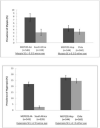Prevalence of myopia and hyperopia in 6- to 72-month-old african american and Hispanic children: the multi-ethnic pediatric eye disease study
- PMID: 19926137
- PMCID: PMC2815146
- DOI: 10.1016/j.ophtha.2009.06.009
Prevalence of myopia and hyperopia in 6- to 72-month-old african american and Hispanic children: the multi-ethnic pediatric eye disease study
Abstract
Purpose: To determine the age-, gender-, and ethnicity-specific prevalence of myopia and hyperopia in African American and Hispanic children aged 6 to 72 months.
Design: Population-based cross-sectional study.
Participants: The Multi-Ethnic Pediatric Eye Disease Study is a population-based evaluation of the prevalence of vision disorders in children aged 6 to 72 months in Los Angeles County, California. Seventy-seven percent of eligible children completed a comprehensive eye examination. This report focuses on results from 2994 African American and 3030 Hispanic children.
Methods: Eligible children in 44 census tracts were identified during an in-home interview and scheduled for a comprehensive eye examination and in-clinic interview. Cycloplegic autorefraction was used to determine refractive error.
Main outcome measures: The proportion of children with spherical equivalent (SE) myopia </= -1.00 diopter (D) and SE hyperopia >/= +2.00 D in the worse eye. Prevalence of myopia and hyperopia is also reported using alternative threshold definitions.
Results: Prevalence of myopia was higher in African American (6.6%) compared with Hispanic children (3.7%; P<0.001). Hispanics showed a higher prevalence of hyperopia than African American children (26.9% vs. 20.8% respectively, P<0.001). The prevalence of myopia showed a significant decreasing trend with age (P<0.001). Hyperopia prevalence reached a low point at approximately 24 months of age but increased and remained higher than that thereafter. No significant gender differences were found in the prevalence of refractive error for either ethnic group.
Conclusions: We observed ethnicity-related differences in both hyperopia and myopia prevalence in preschool children. The age-related decrease in myopia prevalence in preschool children could reflect early emmetropization and contrasts with the increase in myopia prevalence known to occur in older school-aged children. The limits of emmetropization are evident, however, in the persistently elevated prevalence of hyperopia beyond 24 months of age.
Financial disclosure(s): The author(s) have no proprietary or commercial interest in any materials discussed in this article.
Copyright 2010 American Academy of Ophthalmology. Published by Elsevier Inc. All rights reserved.
Figures




Comment in
-
Prevalence of refractive error.Ophthalmology. 2010 Aug;117(8):1652; author reply 1653.e1-2. doi: 10.1016/j.ophtha.2010.03.069. Ophthalmology. 2010. PMID: 20682376 No abstract available.
-
Prevalence of refractive error.Ophthalmology. 2010 Aug;117(8):1652; author reply 1653.e1-2. doi: 10.1016/j.ophtha.2010.03.070. Ophthalmology. 2010. PMID: 20682377 No abstract available.
References
-
- Robaei D, Rose K, Ojaimi E, et al. Visual acuity and the causes of visual loss in a population-based sample of 6-year-old Australian children. Ophthalmology. 2005;112:1275–82. - PubMed
-
- Zhao J, Pan X, Sui R, et al. Refractive Error Study in Children: results from Shunyi District, China. Am J Ophthalmol. 2000;129:427–35. - PubMed
-
- He M, Zeng J, Liu Y, et al. Refractive error and visual impairment in urban children in southern China. Invest Ophthalmol Vis Sci. 2004;45:793–9. - PubMed
-
- Murthy GV, Gupta SK, Ellwein LB, et al. Refractive error in children in an urban population in New Delhi. Invest Ophthalmol Vis Sci. 2002;43:623–31. - PubMed
-
- Maul E, Barroso S, Munoz SR, et al. Refractive Error Study in Children: results from La Florida, Chile. Am J Ophthalmol. 2000;129:445–54. - PubMed
Publication types
MeSH terms
Grants and funding
LinkOut - more resources
Full Text Sources
Medical

